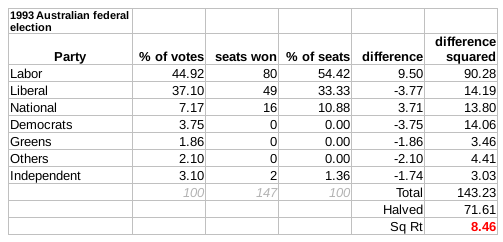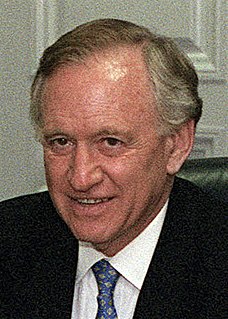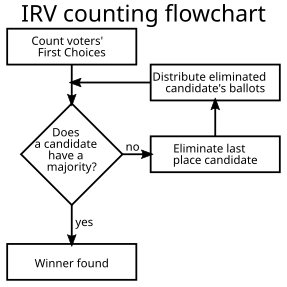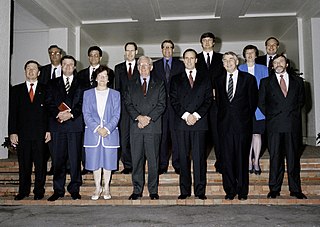
Paul John Keating is a former Australian politician who served as the 24th Prime Minister of Australia, in office from 1991 to 1996 as leader of the Labor Party. He had earlier served as Treasurer in the Hawke Government from 1983 to 1991.

Federal elections were held in Australia on 10 November 2001. All 150 seats in the House of Representatives and 40 seats in the 76-member Senate were up for election. The incumbent Liberal Party of Australia led by Prime Minister of Australia John Howard and coalition partner the National Party of Australia led by John Anderson defeated the opposition Australian Labor Party led by Kim Beazley.

The 1998 Australian federal election was held to determine the members of the 39th Parliament of Australia. It was held on 3 October 1998. All 148 seats of the House of Representatives and 40 seats of the 76-seat Senate were up for election. The incumbent centre-right Liberal/National Coalition government led by Prime Minister John Howard of the Liberal Party and coalition partner Tim Fischer of the National Party defeated the centre-left Australian Labor Party opposition led by Opposition Leader Kim Beazley.

Federal elections were held in Australia on 9 October 2004. All 150 seats in the House of Representatives and 40 seats in the 76-member Senate were up for election. The incumbent Liberal Party of Australia led by Prime Minister of Australia John Howard and coalition partner the National Party of Australia led by John Anderson defeated the opposition Australian Labor Party led by Mark Latham.

The 1996 Australian federal election was held to determine the members of the 38th Parliament of Australia. It was held on 2 March 1996. All 148 seats of the House of Representatives and 40 seats of the 76-seat Senate were up for election. The centre-right Liberal/National Coalition led by Opposition Leader John Howard of the Liberal Party and coalition partner Tim Fischer of the National Party defeated the incumbent centre-left Australian Labor Party government led by Prime Minister Paul Keating.

The goods and services tax (GST) in Australia is a value added tax of 10% on most goods and services sales, with some exemptions and concessions. GST is levied on most transactions in the production process, but is in many cases refunded to all parties in the chain of production other than the final consumer.
The birthday cake interview was a famous interview in Australia between reporter Mike Willesee and Liberal Party Opposition Leader John Hewson shortly before the 1993 federal election. Hewson was unable to easily answer whether a birthday cake would cost more or less under his proposed tax reforms, causing voters to reject the plan as overly complex. It is remembered as the interview which contributed to Hewson's failure to win the election because he was unable to explain one of his key tax policies on live television.
The following lists events that happened during 1992 in Australia.
The following lists events that happened during 1993 in Australia.

Federal elections were held in Australia on 24 March 1990. All 148 seats in the House of Representatives and 40 seats in the 76-member Senate were up for election. The incumbent Australian Labor Party led by Bob Hawke defeated the opposition Liberal Party of Australia led by Andrew Peacock with coalition partner the National Party of Australia led by Charles Blunt. The election saw the reelection of a Hawke government, the fourth successive term.

Federal elections were held in Australia on 11 July 1987, following the granting of a double dissolution on 5 June by the Governor-General Sir Ninian Stephen. Consequently, all 148 seats in the House of Representatives as well as all 76 seats in the Senate were up for election. The incumbent Australian Labor Party, led by Prime Minister Bob Hawke, defeated the opposition Liberal Party of Australia, led by John Howard and the National Party of Australia led by Ian Sinclair.

John Winston Howard, is an Australian former politician who served as the 25th Prime Minister of Australia from 1996 to 2007. He is the second-longest serving Australian Prime Minister, behind only Sir Robert Menzies, who was in office for over 18 years. Howard was leader of the Liberal Party from 1985 to 1989 and from 1995 to 2007.
State elections were held in South Australia on 11 December 1993. All 47 seats in the South Australian House of Assembly were up for election. The incumbent Australian Labor Party led by Premier of South Australia Lynn Arnold was defeated by the Liberal Party of Australia led by Leader of the Opposition Dean Brown. The Liberals won what is still the largest majority government in South Australian history.
Fightback! was a 650-page economic policy package document proposed by John Hewson, federal leader of the Liberal Party of Australia and Leader of the Opposition from 1990 to 1994. It represented the start of their new "dry", economic liberal future policy direction, very different to the keynesianism they previously practised. The package was part of their unsuccessful policy platform at the 1993 election.

A federal election was held on Saturday, 21 August 2010 for members of the 43rd Parliament of Australia. The incumbent centre-left Australian Labor Party led by Prime Minister Julia Gillard won a second term against the opposition centre-right Liberal Party of Australia led by Opposition Leader Tony Abbott and Coalition partner the National Party of Australia, led by Warren Truss, after Labor formed a minority government with the support of three independent MPs and one Australian Greens MP.
The 1995 Wentworth by-election was held in the Australian electorate of Wentworth in New South Wales on 8 April 1995. The by-election was triggered by the resignation of the sitting member, former Liberal Party of Australia leader Dr John Hewson on 28 February 1995. The writ for the by-election was issued on 3 March 1995.

The Keating Government was the federal executive government of Australia led by Prime Minister Paul Keating of the Australian Labor Party from 1991 to 1996. The Government followed on from the Hawke Government after Paul Keating replaced Bob Hawke as Labor leader in an internal party leadership challenge in 1991. Together, these two governments are often collectively described as the Hawke-Keating Government. The Keating Government was defeated in the 1996 federal election and was succeeded by the Howard Coalition government.
The early 1990s recession saw a period of economic downturn affect much of the world in the late 1980s and early 1990s. The economy of Australia suffered its worst recession since the Great Depression.






















